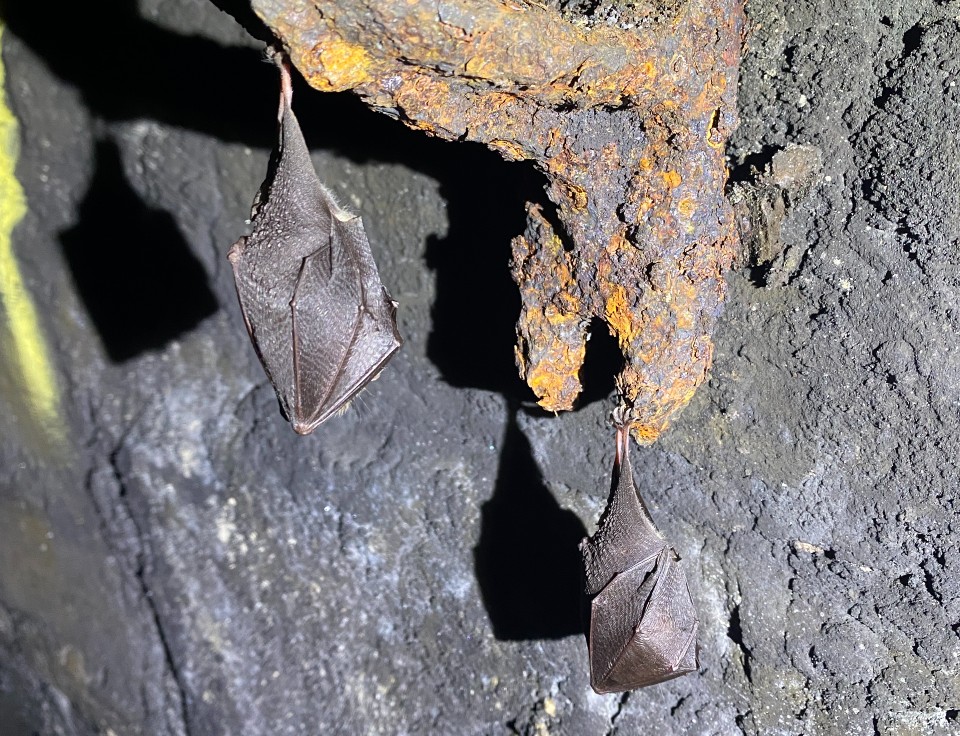5 ways we support bats on the Historical Railways Estate
Published
15 Apr 2025
To celebrate National Bat Appreciation Day (17 April), we’re shining a light on how we protect and support these fascinating and important mammals across the Historical Railways Estate.

Share this article
1. Maintaining their homes
Former railway structures offer ideal roost sites, with stable temperatures and protective crevices. Many of the former tunnel structures are known roost sites for rare bat species — and the maintenance and security of these sites are often to their benefit.
One example of this was during a winter storm when the door on a tunnel portal entrance collapsed at a known hibernation roost for nearly 200 lesser horseshoe bats, and we had to act quickly. Our teams of ecologists and contractors obtained a bat licence (necessary to undertake the repairs) and replaced the door like for like. Thankfully, the quick action of the team meant that the bats were undisturbed, and they continue to use the tunnel for hibernation.

2. Creating new homes
We actively enhance and create new roosts for bats, as part of a licence that legally allows the work to be undertaken to maintain our structures. During necessary works, some existing bat roosts may be compromised — in these cases, we not only replace lost features but also enhance existing or create new dedicated structures.
An example of this was during surveys associated with tunnel repairs in the Cotswolds, where ecologists discovered a whiskered bat hibernating in a deteriorating fogging hut outside the tunnel.
As compensation for the repair of the tunnel, which was also known bat roost, the team carefully modified the structure by sealing the roof to prevent water ingress, bricked up the main entrance while creating a small, bat-sized entrance (protecting the residents from both human disturbance and natural predators), and installed corrugated sheeting at various heights to create the crevices that bats require for roosting.
You can read more about this project here.

3. Enhancing habitats
Former railway lines offer perfect bat highways — their embankments and cuttings provide natural navigation routes with shelter from harsh weather. Most often, the structures can be found away from urban development, so they offer minimal artificial lighting — crucial for light-sensitive bat species. As such, maintenance works at our structures aim to maintain and enhance these wildlife corridors.
A great example of this was a bridge structure in North Wales, which required remedial works for the continued safety of the road above. It was discovered that the bridge was shown to be a night roost for lesser horseshoe bats and a flight path for several other bat species. The planned works to the structure could have led to the loss of a roost, and force bats to fly over the road, increasing the likelihood of collisions with vehicles.
Therefore, modifications to the structure’s repair were made to facilitate and promote continued use by bats. Supplementary planting of grass and shrub plants surrounding the structure was also completed to promote local biodiversity and provide foraging habitat and cover for commuting bat species.
4. The right timing
Whilst maintenance and repairs are often required to ensure the continued safety of our structures, we aim to time our works to minimise any potential disturbance to bats. Some of our structures have been shown to be used for key elements of a bat’s annual life cycle, such as maternity and hibernation roosts.
As such, undertaking works (under licence when required) to avoid these periods, we can complete necessary maintenance and repairs without the bats being present and, therefore, disturbed. While we work to ensure the continued security at our sites to ensure public safety, these efforts — such as preventing access to our tunnel structures — also benefit bat species by creating quiet roost locations that would otherwise be prone to disturbance by trespass.
5. Bringing in the experts
Finally, to undertake any of the necessary repairs on our former railway assets, we instruct a team of ecologists to assess the ecology of the site and recommend the necessary licences and mitigation required. This survey effort is invaluable in accurately assessing the species and populations present, to ensure the continued success of species present. A complex example of this is at a rail bridge in Somerset, where infilling was deemed the most suitable option for the structure, considering safety, ecology, heritage and social factors.
The structure contained roosts used by both lesser and greater horseshoe bats throughout the year for hibernation, day roosting, and night roosting. We installed three specialised replacement structures: two horizontally oriented pipes (2 metres in diameter — one concrete and one plastic for comparison) on the western side and a 1.5-metre diameter vertical ‘pill box’ style concrete pipe on the eastern side.
Each structure featured carefully designed internal elements creating various roosting opportunities and microclimates suitable for multiple bat species. Importantly, all such licensed works include mandatory post-works monitoring, allowing our ecologists to evaluate different approaches and continuously improve their bat conservation techniques.
We continue to balance essential infrastructure maintenance with ecological responsibility across our structures. Through innovative roost designs, habitat enhancement, and continuous monitoring, we’re helping to use Britain's industrial heritage as valuable wildlife sanctuaries. This work demonstrates how human infrastructure, even when abandoned, can play a vital role in protecting not just bats, but wider biodiversity, when managed with care and understanding.
Find out more about our approach to biodiversity.
